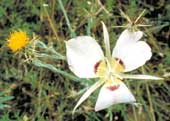 |
 |
|
|
|
|
Invasive Species An invasion is under way that is undermining our economy and endangering our most precious natural treasures. The incursion comes not from foreign armies, political terrorists, or extraterrestrials. Instead, the stealthy invaders are alien species. These plants and animals have been introduced—either intentionally or by accident—into areas outside their natural ranges. Unchecked by natural controls, invasive species are spreading across our lands and through our waterways, and wreaking havoc with already fragile native species and ecosystems. The growing attention to the problem of invasive species often focuses on their costs to agriculture, ranching, forestry, and industry. The price they exact from our natural forests, grasslands, and waterways, however, is at least as great. Invasive species are now regarded as the second-leading threat to imperiled species, behind only habitat destruction. Of 40 North American freshwater fishes that have become extinct over the past century, for example, invasive species were a contributing factor in more than two-thirds of these extinctions. Invasive species affect our native biodiversity in a number of ways. They may compete directly with native species for food or space, may compete indirectly by changing the food web or physical environment, or may prey on or hybridize with native species. Rare species with limited ranges and restricted habitat requirements are often particularly vulnerable to the influence of these alien invaders. This is especially acute in island environments, such as Hawaii, where most species evolved in isolation—without continental competitors, predators, and pathogens—and lack defenses against foreign invaders. An Accelerating Problem As global travel and trade increase, pathways for invasive species to establish themselves in new lands are increasing accordingly. San Francisco Bay, a global shipping crossroads, is invaded by a new alien species on average every 12 weeks. Just a few recent U.S. invasions include:
Combating Invasives Because invasive species have a profound affect on vital sectors of the economy as well as on wildlands and endangered species, a broad coalition has formed to combat the problem. Fighting invasive species received a huge boost in 1999 when President Clinton signed Executive Order 13112, which is designed to "prevent the introduction of invasive species and provide for their control and to minimize the economic, ecological, and human health impacts that invasive species cause." A National Invasive Species Council was created to coordinate the activities of the various federal agencies involved and engage industry, academia, and the environmental community. The Council has issued a National Management Plan that offers a blueprint from which the U.S. federal agencies, along with their partners, can work to minimize the significant impacts of invasive species. Containing the onslaught of invasive species will not be easy or quick, but it is not impossible. Doing so will require work on four fronts:
What is NatureServe Doing? NatureServe is now applying its expertise and leadership in biological information to the issue of invasive species. Key to carrying out the above four steps is reliable information about which invasive species pose the greatest threats, where they currently are found, and where they might spread. With support from the National Fish and Wildlife Foundation and the Turner Foundation, NatureServe and The Nature Conservancy have developed methods for assessing the invasiveness of non-native species. These assessments are designed to identify those invasive species that warrant particular attention based on their potential to cause ecological problems. NatureServe is also working collaboratively with the U.S. Geological Survey to integrate databases on the distribution and condition of native fishes with databases documenting the distribution of non-native fish species. Additional NatureServe Information An Invasive Species Assessment Protocol: Evaluating Non-Native Plants for Their Impact on Biodiversity — A NatureServe publication detailing our new methods for assessing invasive species. Data on initial assessments of 300+ invasive plants are also available here. America's Least Wanted: Alien Species Invasions of U.S. Ecosystems — A NatureServe publication providing an excellent overview of the invasive species problem. Includes profiles of the "Dirty Dozen," a rogues' gallery of some of America's worst aliens. Precious Heritage: The Status of Biodiversity in the United States — This highly regarded NatureServe book contains an overview of threats to biodiversity in the United States (Chapter 8), that includes the analysis by Wilcove et al. establishing invasive species as the second-leading threat to imperiled and endangered species. Other Key Resources National
Invasive Species Council — The U.S. federal government's official coordinating
body on invasive species issues. |
|
||||
|
Copyright © 2008 |
|
Support Us
|

